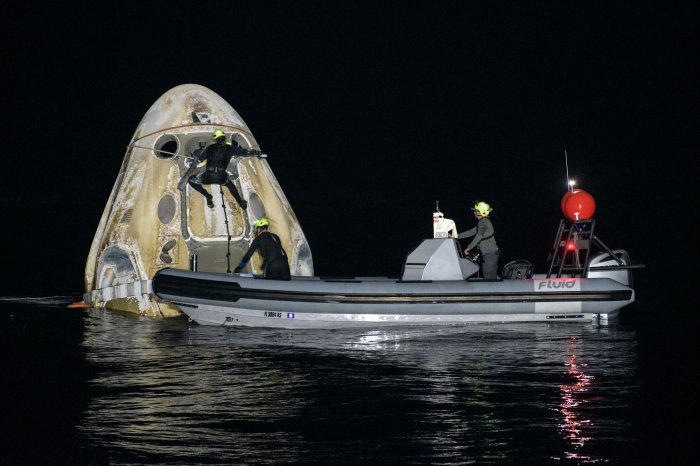1 of 3 | An illustration depicts two NASA astronauts viewing lunar rovers envisioned by Lockheed Martin and General Motors on the moon. Image courtesy of Lockheed Martin
ORLANDO, Fla., May 26 (UPI) -- Two American corporate giants, defense firm Lockheed Martin and automaker General Motors, will develop new lunar rovers for upcoming moon missions, the companies announced Wednesday.
Lockheed and GM plan a fleet of robotic and piloted rovers, which would move farther than Apollo's three so-called moon buggies, according to a news release. The farthest distance an Apollo rover traveled was about 4.7 miles from the landing site.
Such exploration capability will be needed to "support the first excursions of the Moon's south pole, where it is cold and dark with more rugged terrain," the release said.
"These next-generation rovers will dramatically extend the range of astronauts as they perform high-priority science investigation on the moon that will ultimately impact humanity's understanding of our place in the solar system," Rick Ambrose, executive vice president at Lockheed Martin Space, said in the release.
Lockheed and GM did not say they will build rovers -- only that they will develop the technology. The company released no details of the rover's potential design.
The two companies anticipate NASA will release more details about what's needed in a lunar rover later this year, said Jeff Ryder, vice president of growth and strategy for GM's defense business, during a press conference on Wednesday.
Lunar rovers for planned moon missions will need to climb and traverse rough terrain in NASA's planned landing area near the lunar South Pole, said Kirk Shireman, vice president of Lockheed's lunar exploration campaign. That's where NASA believes it can study water ice inside craters.
"To safely land the first woman and the next man on the surface of the moon you need a relatively flat place," Shireman said during the conference. "Unfortunately, the scientists like boulders and they like really rugged craters, that's what they want to look at."
"My vision is that two women in a rover on the moon becomes the iconic picture of what the Artemis generation is, and I can't wait," said Lisa Callahan, vice president of Lockheed's
NASA's timeline for returning to the moon has been delayed repeatedly for decades, but the agency is attempting to stick with a 2024 moon landing date set during the Trump Administration. Congress, however, hasn't provided the funding NASA requested to develop human landing systems by that time.
NASA requested proposals, or information, from potential bidders on lunar rovers in February 2020, just as the world was closing down due to the COVID-19 pandemic.
The agency reported that it received about 30 responses and held a virtual presentation Feb. 12, 2020, to answer questions.
Lockheed and GM attended that event. Also on the attendance list were California-based SpaceX, Virginia-based defense and space firm Northrop Grumman, Colorado-based Maxar Technologies and Minnesota-based Polaris, a manufacturer of off-road vehicles and snowmobiles.
NASA already signed a contract with Pittsburgh-based Astrobotic Technologies to launch a small robotic rover to the moon in 2022 to start exploring the south pole -- the intended area for Artemis missions.
In response to questions about choosing additional rover proposals, NASA provided a statement Tuesday indicating that the process was not complete.
"Later this year, [NASA] plans to hold an industry day and provide the community with updated information, and to help shape the evolution of the Artemis mobility architecture to achieve the greatest scientific and exploration value," the space agency said in the statement.
Support teams work around the SpaceX Crew Dragon Resilience spacecraft shortly after it landed with NASA astronauts Mike Hopkins, Shannon Walker and Victor Glover and Japan Aerospace Exploration Agency astronaut Soichi Noguchi aboard in the Gulf of Mexico off Panama City, Fla., on Sunday. Photo by Bill Ingalls/NASA |
License Photo
















